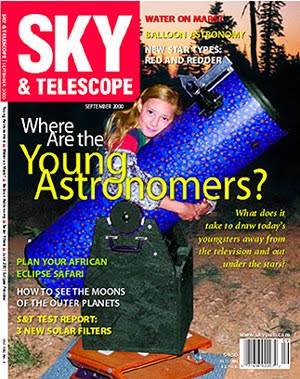October 5, 1996
What a treat it was to do a public program with the Fremont Peak Observatory Association's 30" Challenger reflector telescope. I was assisting Dean Linebarger and Rich Neuschaefer. We also had occasional help from Richard Navarrete and Alan Nelms.
The evening began with SJAA member Rod Norden donning his wizard hat/grey long hair wig and celestially decorated cape, and giving two excellent talks to the public in the meeting room of the observatory. Dean, Rich and I were already involved in locatin g some of the brighter objects for the overflow members of the public who could not fit inside the meeting room.
The day had been hot, and the evening was one of those memorable t-shirt nites, all night long. With sunset around 6:20 p.m., there was a good six hours of observing prior to moonrise. We began with Jupiter, and followed with M22, M57 (which we stayed on for about an hour, as the talk had ended and the crowd all wanted to see "The Ring"), on to M33, M74, The Helix Nebula, NGC 246, The Crab Nebula, The Veil Nebula, M27, NGC 253, M77, NGC 7331 (and companions), Saturn, NGC 891, M13, M42 and, the rea l treat of the night, the Horsehead Nebula.
After much intensive "faint fuzzy" hunting over the past year with Alan Nelms, I found the experience of showing the public some of the bright and famous objects of the autumn and winter skies to be very relaxing and refreshing. Both Dean and Rich commen ted how enjoyable it was as well. And, I have to admit that it is nice to drive to the peak without packing a couple large scopes and related equipment into my truck.
Other SJAA members present (that I saw or know were at the Peak) were, Jack Zeiders, Jim Bartolini, Bill Arnett, Ray Gralak, and Jay Freeman. I'm sure I left some SJAA members, out, and I apologize, and there were also many other telescopes that brought there owners.
If you are an SJAA member that likes working with the public, having a membership in the FPOA in addition to our club, has wonderful benefits. Fremont Peak is still a premier bay area observing site on 3rd quarter and new moon weekends, and within a reasonable drive from anywhere from the peninsula south. Supporting Fremont Peak helps assure that it remains a valuable and enjoyable resource for all astronomy enthusiasts. It is a regular haunt of many experienced observers from the SJAA (and other clubs), and a great place to introduce yourself to some friendly amateur astronomers who can help you improve your observing skills or learn about the "tools of the trade." The only word of warning I offer is that not every night is a t-shirt night, and one should always come prepared with plenty of warm clothing.
If you are interested in trying "the Peak"..... look for our next star party date in the calendar of events in this newsletter. And don't forget... red flashlights only please!






